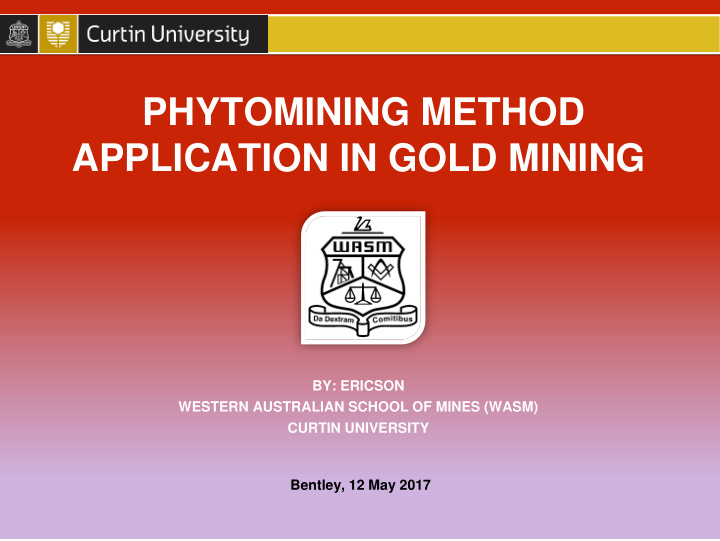



PHYTOMINING METHOD APPLICATION IN GOLD MINING BY: ERICSON WESTERN AUSTRALIAN SCHOOL OF MINES (WASM) CURTIN UNIVERSITY Bentley, 12 May 2017
PRESENTATION OUTLINE 1. INTRODUCTION BACKGROUND AND GOAL 3. METHODS COMPARISON BIOMINING AND CONVENTIONAL MINING METHOD 2. RESEARCH PROJECT PROJECT DISTRIBUTIONS ENTIRE THE WORLD, RESEARCH AND PRODUCTIONS 4. PHYTOMINING TECHNOLOGY CONCEPT, PLAN, IMPLEMENTATION AND RESULT 5.PHYTOMINING’S FUTURE IMPROVEMENT AND ON GOING RESEARCH 6. CONCLUSION CONCLUSION AND RECOMMENDATION 7. REFERENCES OPEN QUESTION AND DISCUSSION
1. INTRODUCTION TO PHYTOMINING 1.1 Background • Conventional mining (mechanical equipment) impacts on the environments • Abundant amount of low-grade ores (gold) • Low cost mining and gold prices • Remarkable ability of plants to accumulate metals Figure1. Conventional Mining • Industrial synergies 1.2 Goal • Introducing phytomining method • Reducing poor environmental consequences of mining Figure2. Gold Price Trend Source: http://goldprice.org/gold-price-australia.html • Maximising ore (gold) [Accessed 11 May 2017]
1.3 Terminology and Definitions Phytoext xtract ctio ion is to extract metal from soil substrate where plants capable of growing in high mineral environments (Chaney et al., 1998) Phyt hytom omining of gold involves extracting gold from soil substrates by harvesting specially selected hyper- accumulating plants (Sheoran, S.Sheoran, & Poonia, 2013) Figure2 Plants Accumulate Metals Source: https://motherboard.vice.com/de/article/phytomining [Accessed 10 May 2017]
2. METHODS COMPARISON Phytomining Conventional Mining SCALE. SCALE Small scale mining Large scale mining application EQUIPMENT EQUIPMENT Hyperaccumulating plants Sophisticated mining equipment and chemical substances ECONOMIC BEENEFIT ECONCOMIC BENEFIT Depends on metal concentration High economic benefit And are covered CAPITAL INVESTMENT CAPITAL INVESTMENT Low capital investment Huge capital investment ENVIRONMENTAL IMPAC ENVIRONMENT IMPACT Intermediate to significant impact Less environment impact MINERAL DEPOSIT MINERAL ORE DEPOSIT Primary deposit, deep reserve Surface ore, or mineralised soil FUTURE RELIABILITY FUTURE RELIABILITY Depends on exploration and It is promising method Resources condition and green approach for mining
3. PHYTOMINING RESEARCH PROJECTS Table1 Example Plant Species Which Hyperaccumulate Elements Source: (Chaney & Baklanov, 2017)
4. PHYTOMINING TECHNOLOGY UNDERSTANDING OBJECT Collecting information of metal and its properties as well as plant behaviour toward chemical COLLECTING INFORMATION Gathering relevant information that LOREM IPSUM can support the study of Lorem ipsum dolor sit amet phytomining in gold metal PHYTOMINING ANALYSING INFORMATION TECHNOLOGY Filtering and Concluding related information and then, synthesising LOREM IPSUM previous research to be develop Lorem ipsum dolor sit amet INTERDISCIPLINE COORDINATION Mining, Environment, Metallurgy, LOREM IPSUM Biology, and Genetic Enginering Lorem ipsum dolor sit amet LOREM IPSUM Lorem ipsum dolor sit amet
4.1 Factor Influencing Phytomining Hyperaccumulating Plants associated plants Factors Soil pH TOLS Soil associated Fertilizer F Chelates SOIL ASSOCIATED PLANT ASSOCIATED Figure3 Factors Influencing Phytomining Source: (Sheoran et al., 2013)
Table2 Hyperaccumulator Plants for various metal Source: (Sheoran, Sheoran, & Poonia, 2009)
Table3 Metal Concentration and Biomass Production Source: (Sheoran, Sheoran, & Poonia, 2009)
4.1 Phytomining Process Figure4 Integrated Process of Gold Figure5 Process of Phytomining Phytomining Source: (Sheoran, Sheoran, & Poonia, 2009) Source: (Anderson et al., 1999)
4.2 Gold Phytomining Lifting Mechanism 4. Detoxification and Sequestration Distribution (Trichome, epidermis, mesophyll, cell wall and vacuoles) Detoxification (Chemical conversion, complexation with amino acid) Sequestration (Vacuoles) 3. Transporting TRA RANSP SPORT T TO S SHOOT Transported using Xyl ylem em Tranp anport xylem After bio activation, Root exudates, micro- organism exudates CHELA LATE ADDIT ITIO ION and cyanogenic. ROOT T UPTAKE TAKE 1. Metal Solubilisation 2. Uptaking into The Roots ROOT T HAI AIR Gold is immobile and Gold is soft acid in its insoluble in soil. However, cation form. It could it can be mobilised by bind with soft base cyanogenic plants and like S and N. microbial activity. It can be absorb by (Sheoran et al., 2013) root plant. Figure6 Lifting Mechanism
4.3 Chemical use in Phytomining Table4 Chemical Use in Phytomining Source: (Wilson-Corral, Anderson, & Rodriguez-Lopez, 2012)
4.4 Phytomining Scenario Figure6 Phytomining Application in Tailing Dump Source: (Hunt et al., 2014)
4.5 The Economics of Phytomining Soil Metal Plant The metal uptake biomass metal content by the prices plant (gold) Figure7 Economics Factors of Phytomining Source: (Cited from Brooks et.al,1998 and Harris et.al.,2009 in Sheoran et al.,2013)
4.6 The Economics of Phytomining (Continued) Using a crop of B. juncea and chelating agent NaCN. Figure8 Pro fi tability versus soil gold concentration Source: (Sheoran et al., 2013)
5. PHYTOMINING IN THE FUTURE 5.1 Phytomining Limitations Climate and Seasonal Dependence Chemical Accumulation Geochemical Factors in soil LIMITATIONS TEMPLATE BY ADIOMA.COM
5.2 Phytomining Improvements Figure9 Improvement Strategy of Hyperaccumulators Source: (Sheoran et al., 2009)
6. CONCLUSION PUBLIC PHYTOMINING IS ACCEPTANCE RELIABLE METHOD - Phytomining will be accepted - Phytomining is economically by most people. and technically reliable to be used in low concentration gold metal. ECOFRIENDLY SUSTAINABLE METHOD MINING - - It has almost sustainable Phytomining could reduce mining parameters and significantly environmental compatible with the demand damage that might cause by of green economic campaign surface mining method. INDUSTRIAL SINERGIES FURTHER STUDY - This method can include some related disciplines to It is suggested to study plant research suitable plants for genetics to improve plants application. extraction performance. BIOMASS ENERGY In line with gold extraction, it can also generate another source of energy, for example biomass.
7. REFERENCES Anderson, Christopher, Fabio Moreno, and John Meech. 2005. "A Field Demonstration of Gold Phytoextraction Technology." Minerals Engineering 18 (4): 385-392. doi: https:// doi.org/10.1016/j.mineng.2004.07.002. Chaney, Rufus L, and Ilya A Baklanov. 2017. "Phytoremediation and Phytomining: Status and Promise." Advances in Botanical Research. Robinson, B. H., C. W. N. Anderson, and N. M. Dickinson. 2015. "Phytoextraction: Where’s the Action?" Journal of Geochemical Exploration 151: 34-40. doi: https:// doi.org/10.1016/j.gexplo.2015.01.001. Sheoran, V., A. S.Sheoran, and P. Poonia. 2013. "Phytomining of Gold: A Review." Journal of Geochemical Exploration 128: 42-50. doi: https://doi.org/10.1016/j.gexplo.2013.01.008. Sheoran, V., A. S. Sheoran, and P. Poonia. 2009. "Phytomining: A Review." Minerals Engineering 22 (12): 1007-1019. doi: https://doi.org/10.1016/j.mineng.2009.04.001. Wilson-Corral, Victor, Christopher W. N. Anderson, and Mayra Rodriguez-Lopez. 2012. "Gold Phytomining. A Review of the Relevance of This Technology to Mineral Extraction in the 21st Century." Journal of Environmental Management 111: 249-257. doi: https://doi.org/10.1016/j.jenvman.2012.07.037.
THANK YOU
8. QUESTION AND ANSWER Q&A
Recommend
More recommend